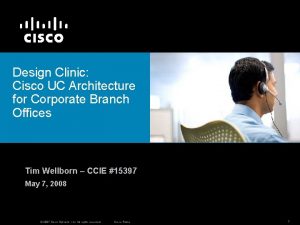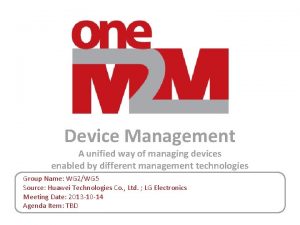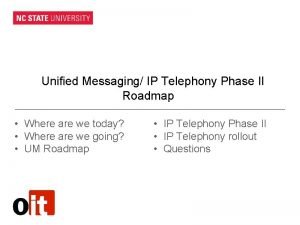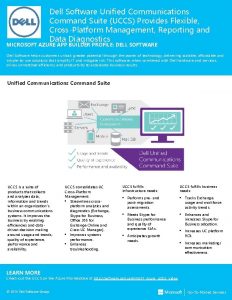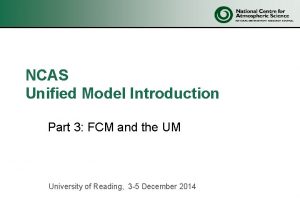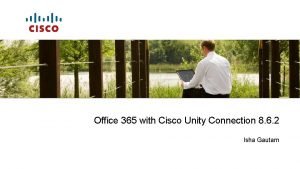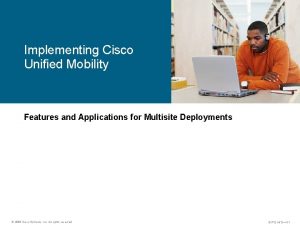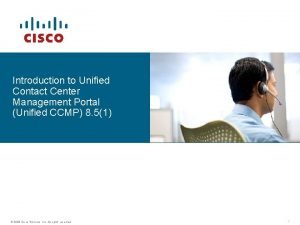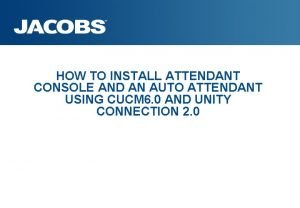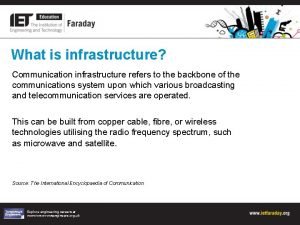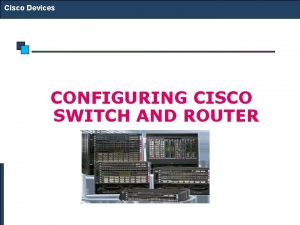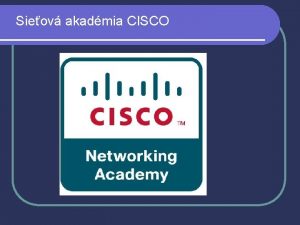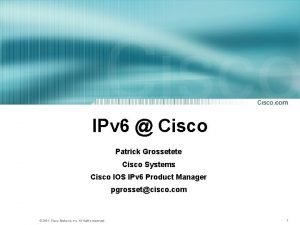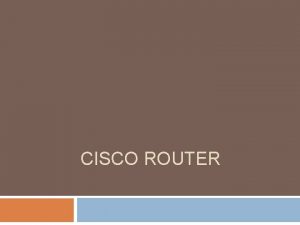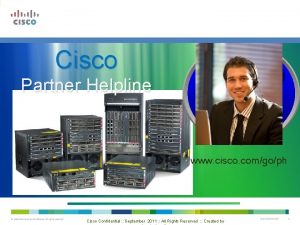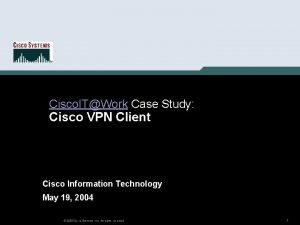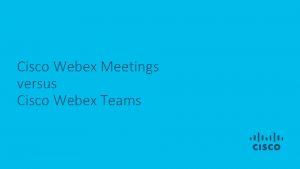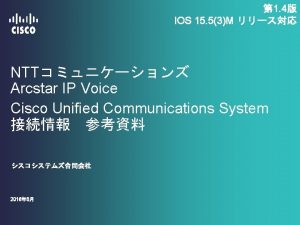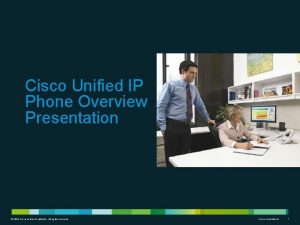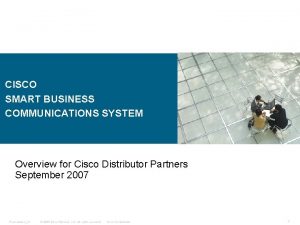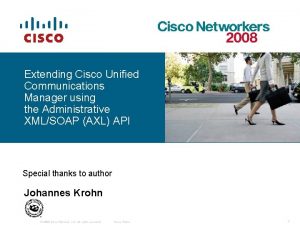Unified Communication Infrastructure Lecture 5 Cisco Unified Communications





















































- Slides: 53

Unified Communication Infrastructure Lecture 5


Cisco Unified Communications Manager Signaling and Media Paths Cisco Unified Communications Manager Express Signaling Protocol (SCCP / SIP) IP Phone A (SCCP / SIP) Media Exchange — (RTP) § Cisco Unified Communications Manager performs call setup using a Signaling Protocol (SCCP/SIP). § Media exchange occurs directly between endpoints using RTP. IP Phone B





Gateway Hardware Platforms (Cont. ) • Special voice gateways: Cisco VG 224 and VG 248 Gateways Cisco AS 5850 Gateway Cisco AS 5300 and AS 5400 Series Gateways Cisco 827 -4 V Router EOS: 05/2005 EOL: 05/2010 Cisco ATA 186 Cisco 7200 Series Routers

Gateway Hardware Platforms • Modern enterprise models: Cisco 2800 Series Routers Cisco 3800 Series Routers Cisco Catalyst 6500 Series




Cisco Catalyst Family of Switches Cisco Catalyst 6500 Cisco Catalyst 4500 Cisco Catalyst 3750 Cisco Ether. Switch Network Module Cisco Catalyst 3560

Three Ways to Power Cisco IP Phones – Power over Ethernet (Po. E): – Needs Po. E line cards or Po. E ports for Cisco Catalyst switches – Delivers 48 V DC over data pairs (pins 1, 2, 3, and 6) or spare pairs (pins 4, 5, 7, 8) – Midspan power injection: – Needs external power source equipment – Delivers 48 V DC over spare pairs – Wall power: – Needs DC converter to connect a Cisco IP phone to a wall outlet Power Injector No Power AC Source Power 110 V AC Wall Power to 48 V DC Converter


Two Types of Po. E Delivery Cisco original implementation: – Provides -48 V DC at up to 6. 3 to 7. 7 W per port over data pins 1, 2, 3, and 6. – Supports most Cisco devices (Cisco IP phones and wireless access points). – Uses a Cisco proprietary method of determining if an attached device requires power. Power is delivered only to devices that require power. IEEE 802. 3 af Power over Ethernet: – Specifies 48 V DC at up to 15. 4 W per port over data pins 1, 2, 3, and 6 or spare pins 4, 5, 7, and 8. – Enables a new range of Ethernet-powered devices because of increased power. – Standardizes the method of determining if an attached device requires power. Power is delivered only to devices that require power. – Has several optional elements, including power classification.

Cisco Prestandard Device Detection Cisco Prestandard Implementation Powered Device Port Pin 3 FLP Switch It is an inline device. Pin 6 Rx FLP Pin 1 Pin 2 Tx

IEEE 802. 3 af Device Detection IEEE 802. 3 af Powered Device IEEE 802. 3 af PSE Switch It is an IEEE powered device. 2. 8 V to 10 V Pin 3 Detect Voltage Pin 6 Rx Pin 1 Pin 2 Tx 25 K Ohm Resistor









Redundancy Design Primary Secondary or Backup 7500 IP phones Cisco MCS 7845 Publisher and TFTP Server (Not Req. <1000) Primary 1 to 7500 15, 000 IP phones Cisco MCS 7845 Publisher and TFTP Server Backups 1 to 7500 30, 000 IP phones Cisco MCS 7845 Publisher and TFTP Server Backups 7501 to 15, 000 1 to 7500 7501 to 15, 000 Backups 15001 to 22, 500 22, 501 to 30, 000

Dial Plans

Dial and Numbering Plans • A numbering plan describes the endpoint addressing in a telephony network • Same as IP addressing in an IP network • There are private and public numbering plans – the same as private and public IP addressing schemes • Dial plans present the biggest challenge to a Vo. IP network administrator!

Dial Plans • Dial plans analyze, screen and route calls based on dialled digits. • Dial plans specify how to interpret digit sequences dialled by the user. • Dial plans convert those into an outbound dial string. • On Cisco voice gateways, dial plans must be manually configured • They are basically a collection of dialled peers

Problems • Unlike IP addresses a caller can input any combination of numbers from a dial. • A wrong IP address can be dropped immediately but dialled digits must be analysed. • There a few possibilities for destinations;

Destinations or Peers • • • Local Vo. IP phone extension number Local POTS phone number (FXS port) Local POTS exchange number (FXO port) Distant Vo. IP extension number (WAN) Distant POTS number (WAN)

Caution • You are expected to be able to establish a connection with emergency services from a Vo. IP extension. • You also must provide access to all other services such as free-phone low-call etc. . • You are expected to bar certain Peers • You are expected to limit certain extensions capabilities

Public Numbering Plans • • Emergency services Directory services Local calling Mobile calling Long-distance calling Toll-free calling International calling Premium calling

National Numbering Plan • • 00 – International 071 – Regional area code 071 - 91 – City area code!! 18 – Free call and Low call 08 – Mobile network 15 – Premium rate service 112 or 999 – Emergency service 11811 – Directory enquiries (note similarity with 112 service)

Private Numbering Plans • Is used within a single organization • Several factors need to be considered when designing such a numbering plan 1. Number of addressable devices 2. Number of locations 3. Methods of assigning site codes 4. Inbound call routing 5. External (PSTN) call routing

Scalable Dial Plans a) b) c) d) e) Logical distribution Hierarchical numbering plan Provisioning simplicity Reduction in post-dial delay Fault Tolerance

a) Logical Distribution • Local gateway should handle details that are specific to its function • High level routing decisions should be passed on to Gatekeepers and PBX systems

b) Hierarchical numbering plan • Simplifies provisioning tasks • Simplifies call routing by keeping local calls local and using access code for long distance • Provides summarization by providing groups of numbers in different locations • Adds scalability • Simplifies management – can be controlled from a central point

c) Provisioning simplicity • Avoid overlapping numbering plans and extension ranges • Use digit manipulation where desired to standardize number patterns

d) Reduction in post-dial delay • Users of PSTN have little or no post-dial delay • Minimize the number of dial peers and translations • The more translations and lookups – the longer the post-dial delay

e) Fault Tolerance • For critical sites, redundant gateways can be implemented. • Alternate routes should be available • This is usually established in the network design anyway

Digit Manipulation • • • Digit stripping Forwarding dialled digits Adding prefixes to dialled numbers Manipulating Caller ID Number expansion Voice translation profiles

Examples of Dial Peers Voice Gateway Router Configuration File voice-port 1/0/0 ! voice-port 1/0/1 ! dial-peer voice 1 pots destination-pattern 5551234 port 1/0/0 dial-peer voice 2 pots destination-pattern 5555678 port 1/0/1

Voice Gateway Router 1 Configuration voice-port 1/0/0 ! dial-peer voice 1 pots destination-pattern 5551234 port 1/0/0 ! dial-peer voice 10 voip destination-pattern 5555678 session target ipv 4: 10. 5. 6. 7 codec g 711 ulaw

Voice Gateway Router 1 Configuration File voice-port 1/0/0 ! dial-peer voice 1 pots destination-pattern 5551234 port 1/0/0 ! dial-peer voice 2 voip destination-pattern 5555678 session target ipv 4: 10. 5. 6. 7 Voice Gateway Router 2 Configuration File voice-port 1/0/0 ! dial-peer voice 1 pots destination-pattern 5555678 port 1/0/0 ! dial-peer voice 2 voip destination-pattern 5551234 session target ipv 4: 10. 2. 3. 4

Digit stripping (default)

Forwarding dialled digits

Other Examples - Communication Between Dial Peers Sharing the Same Router

Matching call legs to Dial-Peers

Dial Peers from the perspective of the both routers

Figure 6 - Sample Vo. IP Network Three telephone numbers in the sales branch office need dial peers configured for them. Router B is the primary gateway to the main office; as such, it needs to be connected to the company's PBX. Four devices need dial peers, all of which are connected to the PBX, configured for them in the main office.

Dial Peer Configuration Table for Sample Voice over IP Network in Figure 6
 Unified communications infrastructure
Unified communications infrastructure Unified communications infrastructure
Unified communications infrastructure What is cucm
What is cucm Lumen cisco collaboration
Lumen cisco collaboration Processing model
Processing model Open source unified communication
Open source unified communication Open platform communications unified architecture
Open platform communications unified architecture Who are puma unified communications
Who are puma unified communications Open source unified communications
Open source unified communications Oma-dm client high cpu
Oma-dm client high cpu Bt cloud backup
Bt cloud backup Unified communications roadmap
Unified communications roadmap Hp unified communications
Hp unified communications Unified communications evolution
Unified communications evolution Unified communications for financial services
Unified communications for financial services Virtual reality unified communications
Virtual reality unified communications Unified communication
Unified communication Who are puma unified communications
Who are puma unified communications Voip presentation
Voip presentation Unified communications command suite
Unified communications command suite Grapevine unified communications
Grapevine unified communications Who are puma unified communications
Who are puma unified communications Crisis communication lecture
Crisis communication lecture Cisco personal communications assistant
Cisco personal communications assistant 01:640:244 lecture notes - lecture 15: plat, idah, farad
01:640:244 lecture notes - lecture 15: plat, idah, farad Cisco nfv infrastructure
Cisco nfv infrastructure Dcloud cisco
Dcloud cisco Unity connection office 365
Unity connection office 365 Cisco unified mobility
Cisco unified mobility Ccmp cisco
Ccmp cisco Cisco unified contact center management portal
Cisco unified contact center management portal Cisco unified cm assistant console
Cisco unified cm assistant console Cisco unified callconnector
Cisco unified callconnector Cisco unified callconnector
Cisco unified callconnector What is communication infrastructure
What is communication infrastructure Komponen communication infrastructure
Komponen communication infrastructure Hybrid communication infrastructure
Hybrid communication infrastructure Bt unified communication
Bt unified communication Cisco pstn
Cisco pstn Business communication lecture slides
Business communication lecture slides N parallel
N parallel What is oral communication and written communication
What is oral communication and written communication Serial and parallel communication
Serial and parallel communication Different types of mass communication
Different types of mass communication Difference between oral and written communication
Difference between oral and written communication Serial communication vs parallel communication
Serial communication vs parallel communication Crisis communication working group
Crisis communication working group Tfc t10 cable
Tfc t10 cable Nims communications and information management
Nims communications and information management It means communication at a distance
It means communication at a distance 113-571-1022
113-571-1022 Performing voice communications army
Performing voice communications army Communication mix
Communication mix Oracle communications services gatekeeper
Oracle communications services gatekeeper




